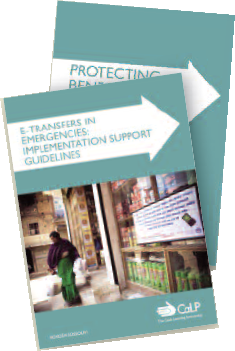CALP guidance on e-transfers in emergencies
 Globally, cash payments to poor people from governments, aid agencies or the private sector are in the order of magnitude of billions. Meanwhile, the rapid spread of technologies enabling branchless banking and digital payment systems has supported the increased consideration of electronic transfers (e-transfers) by aid agencies. Over the last five years alone, the Cash Learning Partnership (CaLP) recorded 41 e-transfer programmes worldwide targeted at over 3.3 million beneficiaries in emergency settings.
Globally, cash payments to poor people from governments, aid agencies or the private sector are in the order of magnitude of billions. Meanwhile, the rapid spread of technologies enabling branchless banking and digital payment systems has supported the increased consideration of electronic transfers (e-transfers) by aid agencies. Over the last five years alone, the Cash Learning Partnership (CaLP) recorded 41 e-transfer programmes worldwide targeted at over 3.3 million beneficiaries in emergency settings.
In 2011, the Cash Learning Partnership (CaLP) commissioned a report to investigate the benefits and barriers to using new technologies in humanitarian cash programmes. Building on this, in 2013, CALP launched a research initiative focused exclusively on etransfers to build evidence and capacity to develop standards and tools for the humanitarian sector. Specifically this work will result in three publications that will provide guidance on e-transfer programme implementation, an analysis of the cost effectiveness of e-transfers compared to manual cash transfers, and beneficiary data protection advice.
Two of these publications, E-transfers in Emergencies: Implementation Support Guidelines and Protecting beneficiary privacy: Principles and operational standards for the secure use of personal data in cash and e-transfer programmes have been released.
E-transfers in emergencies guidelines
The guidelines are intended for field practitioners of aid agencies engaged in humanitarian responses incorporating cash transfers to be delivered through digital payment systems, as well as their extended teams in management and programme support functions.
Internal agency guidelines and procedures do not always include specific guidance on the use of e-transfers and the engagement of the private sector. The CALP guidelines thus seek to provide a basic understanding of e-transfer systems, propose a framework for evaluating the various e-transfer options available, and offer guidance on how to use these options in the delivery of humanitarian assistance.
The guidelines assume prior knowledge of cash transfer programming and focus exclusively on implementing e-transfers; they do not elaborate on decisions relating to whether or not cash is a viable programme option. Therefore, the programme lifecycle begins with assessing which e-transfer option is best suited to deliver a given cash-based intervention. For readers seeking more in-depth information on cash transfer programme management in general, a guidance sheet on cash transfer reference documents in provided. Extensive additional material is also available on the CaLP website (www.cashlearning.org).
Principles and operational standards guidelines
These guidelines aim to enable agencies to meet and respect these international standards and in particular to address risks inherent in the use of beneficiary data by agencies engaged in the delivery of cash, with a specific focus on e-transfer programmes. Annexes include a model privacy impact assessment and model clauses for contracts with third parties.
Feedback
The CaLP is keen to receive feedback from the use of these guidelines. Organisations are invited to send their thoughts and share their programme experiences at info@cashlearning.org and join the CaLP discussion group (by using the link on website www.cashlearning.org).
These guidelines, together with many other cash-related resources, are available on the CaLP website, http://www.cashlearning.org/


